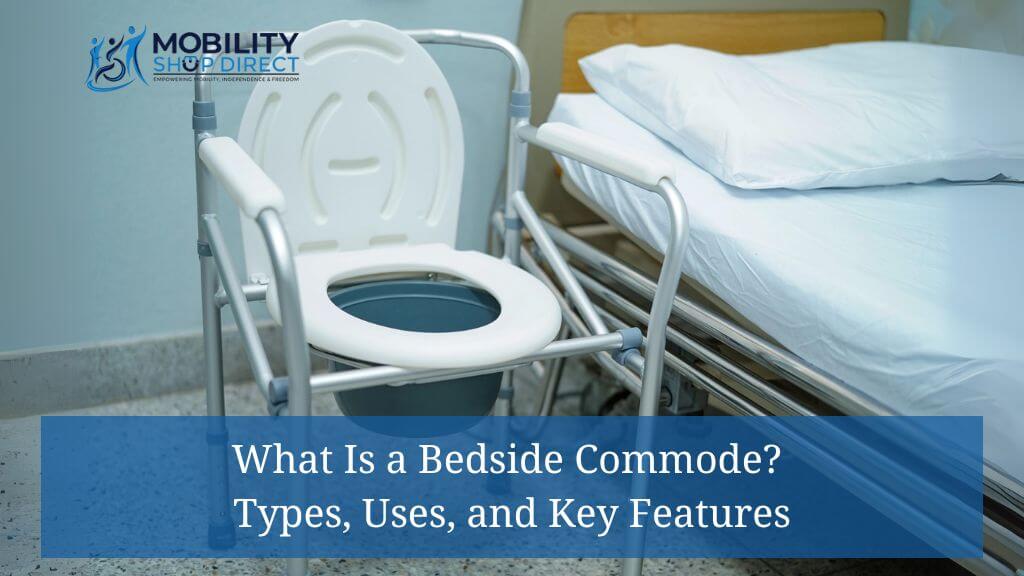What happens when a simple daily activity, like using the bathroom, becomes a challenge? For individuals with limited mobility, this is more than an inconvenience, it’s a question of safety, independence, and dignity. This is where a bedside commode becomes an invaluable solution. Designed as a portable, user-friendly tool, a bedside commode bridges the gap between accessibility and independence, making bathroom trips safer and more convenient for those with mobility challenges.
Whether you’re caring for an aging loved one, recovering from surgery, or seeking a mobility aid to improve quality of life, understanding how a bedside commode works is key to making the right choice. From multifunctional 3-in-1 designs to bariatric models that provide robust support, there’s a wide range of options tailored to varying needs and preferences.
In this guide, we’ll break down the features, types, and practical uses of bedside commodes, so you can confidently select the one that best aligns with your requirements. Ready to find the perfect solution for you or your loved one? Let’s dive in.
Table of Contents
- What Is a Bedside Commode? Definition and Purpose
- Types of Bedside Commodes: Choosing the Right One
- How to Use and Set Up a Bedside Commode
- Comparing Bedside Commodes to Other Bathroom Solutions
- Cleaning and Maintaining a Bedside Commode
- Key Features to Look for in a Bedside Commode
- Conclusion
What Is a Bedside Commode? Definition and Purpose
Understanding Bedside Commodes: A Portable Bathroom Solution
A bedside commode is a portable toilet designed to provide essential bathroom functionality for individuals with mobility challenges. It features a chair-like frame with a built-in seat and a removable bucket, offering a convenient solution that eliminates the need for lengthy, often precarious trips to a traditional bathroom.
These devices are especially helpful for the elderly, people recovering from surgery, or those who have trouble with balance or muscle strength. For example, someone recovering from hip replacement surgery may find it difficult to walk to a distant bathroom, especially at night. A bedside commode placed nearby can lower the risk of falls and increase overall safety.
They also support a sense of independence. Instead of needing hands-on help, users can handle personal hygiene needs more privately. This not only boosts dignity but also reduces the physical strain on caregivers. Bedside commodes play a key role in promoting both safety and autonomy for those dealing with limited mobility.
Types of Bedside Commodes: Choosing the Right One
3-in-1 Bedside Commode Chairs
A 3-in-1 bedside commode gets its name from its flexibility. It can work as:
- A standalone portable toilet
- A raised toilet seat when placed over a standard toilet
- An over-the-toilet safety frame
This versatility makes it useful for short-term recovery or long-term support. Some models are water-resistant and even double as shower chairs. If you’re unsure which type suits your needs, you can learn more by reading how to choose the right bedside commode.
Bariatric Bedside Commodes
These are built for users who need higher weight support, typically between 500 and 1,000 pounds. They use durable materials like reinforced steel and have wider seating to ensure comfort and stability. This extra support helps people feel safer when using the commode.
Folding and Portable Bedside Commodes
If space is tight or you need something easy to transport, folding commodes are a solid option. These models collapse flat and are ideal for travel or short-term use, like after an injury or surgery.
They’re also handy for caregivers working in different homes. Despite being lightweight, many models still have important safety features like slip-resistant caps and adjustable legs.
Adjustable Height and Specialized Features
Not everyone needs the same setup. Many commodes come with adjustable height to help users sit and stand more comfortably. Specialized features include padded seats, waterproof construction, and removable armrests. These options let you tailor the commode to specific needs.
If you want a full overview of what makes a good bedside commode, check out our collection of bedside commodes designed for comfort, convenience, and support.
How to Use and Set Up a Bedside Commode
Placement and Installation Tips
Set up the commode in a place that’s easy to reach, especially at night. If you're placing it over a toilet, make sure it's stable and level. Use non-slip pads and check that adjustable legs are locked in.
Using a Bedside Commode Effectively
Before use, make sure the bucket is empty, clean, and secured. Encourage users to use armrests while sitting and standing. Afterward, empty the bucket and clean it thoroughly. Here’s a guide on how to clean and maintain your bedside commode to make sure it stays safe and sanitary.
Comparing Bedside Commodes to Other Bathroom Solutions
Bedside Commodes vs Bedpans: Which Is Better?
Bedpans can be useful, but they usually require more help from a caregiver and may feel uncomfortable over time. A bedside commode offers more support and feels closer to using a real toilet, which can make a big difference in comfort and privacy.
Bedside Commodes vs Traditional Toilets
Getting to a traditional toilet can be a challenge for some. Stairs, long hallways, or poor lighting increase the risk of falls. A bedside commode cuts down those risks by keeping everything within reach.
For a deeper comparison and help with decision-making, you might want to read this breakdown of bedside commode types and uses.
Cleaning and Maintaining a Bedside Commode
Easy Cleaning Features
Most models have removable buckets with handles for quick emptying. Some also support disposable liners to make cleanup easier. After each use, wash with soap and water, then use a disinfectant to keep things hygienic.
Maintenance Tips for Longevity
Check regularly for loose screws, worn-out caps, or misaligned legs. If you’re using a folding commode, store it in a dry place to prevent rust. These small checks help your commode last longer and stay safe to use.
Key Features to Look for in a Bedside Commode
- Weight Capacity and Stability: Make sure it can comfortably support the user’s weight.
- Material Quality: Reinforced steel or aluminum frames offer better durability.
- Adjustability and Comfort: Features like adjustable legs and padded seating make daily use easier.
- Affordability and Value: Focus on core features that improve safety and usability.
Conclusion
A bedside commode isn’t just practical, it’s a way to support independence, safety, and daily comfort. Whether you need a short-term solution during recovery or a long-term aid for mobility support, the right commode can make everyday life easier.
Think through your needs, explore different features, and choose something that fits your situation. The peace of mind it brings is worth it—for both users and caregivers alike.



